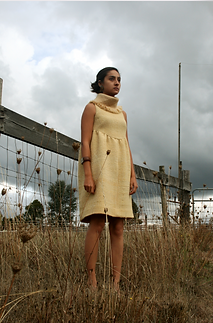PASTORAL TEXTILES
OBJECTIVES
In 2011, I relocated to Portland, Oregon, to research and document the viability of making sustainable garments in the Northwest region of the US. This work follows garment production from start to finish; raising sheep, processing wool, spinning yarn, weaving fabric, natural dyeing, and garment construction in collaboration with local designers. Though each of these processes demands a lifetime to master, this MFA Practicum highlighted specific aspects of each to argue for resource provenance and supply chain transparency. The intention is to present beautiful garments that inspire consumers and makers to question the origin of their clothing. This project's scope contributes to the Slow Fashion Movement by reconsidering production venues with community-centered values.



VISIONING
Most garments we wear contain fiber grown in one country, woven in another, sewn in a third, then shipped to the United States for cheap sale. While this process allows for low-priced goods, it compromises the health of economies, people, and land. Pastoral is a response to this global issue and explores the viability of making sustainable garments in the Northwest region of the United States.
Over two years, the practicum covered many garment design, development, and production aspects. I had to strategize what parts were realistic and what factors required collaboration.






STARTING
As soon as my feet hit the ground in Oregon, I went to Oregon's Flock and Fiber Festival. There, I witnessed sheep being shorn. I talked to sheep growers and started to scratch the surface of this supply chain.
SOURCING | SUPPLY CHAIN MAPPING
To better understand wool production in the United States, building relationships with sheep growers was essential. I started in the Willamette Valley and expanded to eastern Oregon. I learned which breeds thrived in this environment, the history of wool growing in Oregon, and the industry's current state. The issue wasn't the wool but the lack of spinning mills. Due to this discrepancy, my supply chain had to expand beyond state lines into the Mid-West.
NATURAL DYES
One of the two aspects I chose to produce by hand was pigments from plants, i.e., natural dyes. I chose this type of dye because of its light footprint on a small scale and its low chemical impact on people and the planet. I wanted to ensure the pigments I used were colorfast, lightfast, and ethically sourced. This entailed an independent study of native and naturalized plants of the PNW and an analysis of their pigments.
WEAVING | COLLABORATION
Once I had mastered my color palette, I moved on to a textile palette. For this project, it was more important for me to focus on textile design and production. I connected with four PNW apparel designers and one accessory designer to see my vision through to the end product.
I met with each designer to discuss fabrics. I presented swatches of my work and asked each of them what resonated with them and their aesthetic. Over four months, I created a swatch library of woolen textiles and continued to meet with the designers. The meetings concluded with an idea of the type of textile I was to weave and the amount I needed to incorporate for each garment.
Over four months, I wove and delivered fabric to each designer. We would continue to collaborate as they designed and produced each piece.
PROCESS

The finished collection included three woolen vests by Adam Arnold (above), a dress by Amanda Melbostad, a shirt by John Blasioli, a tie by Bowyer & Fletcher, and an assortment of woolen scarves. This project, also my MFA practicum, was awarded both program awards of the Pacific Northwest College of Arts Applied Craft and Design program: Practicum and Program awards.
OUTCOME









